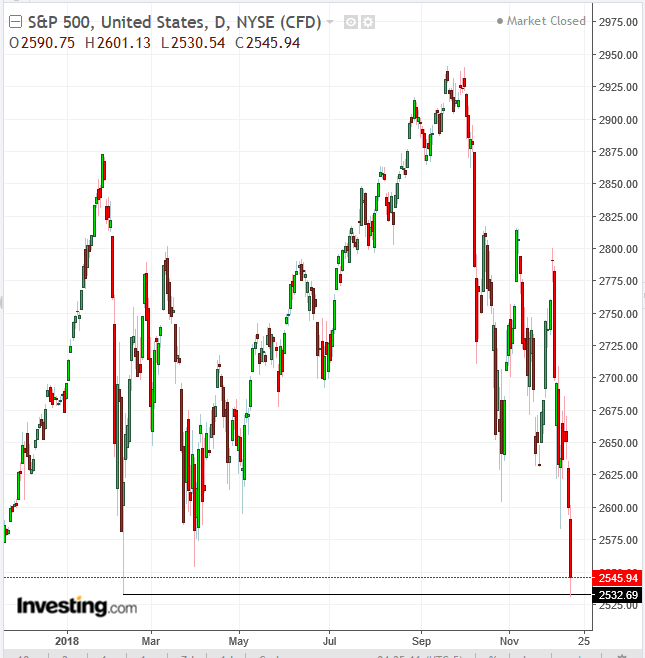- Futures bounce back ahead of Fed
- Yields, dollar fall, gold and yen jump on risk-off
- S&P 500 sinks to 14-month lows
- The Fed holds its final policy meeting of 2018 on Tuesday and Wednesday. The rate decision will be followed by a press conference with Chairman Jerome Powell.
- The Bank of Japan’s monetary policy decision is due on Thursday, followed by a briefing from Governor Haruhiko Kuroda. A Bank of England decision is also due on Thursday.
- A partial US government shutdown could start this week as the standoff continues between lawmakers and US President Donald Trump over $5 billion budget funds for a security wall along the Mexican border.
- Futures on the S&P 500 gained 0.2 percent as of 8:07 a.m. London time.
- The Stoxx Europe 600 edged 0.4 percent lower to the lowest in more than a week.
- The MSCI Asia Pacific Index dropped 1 percent to the lowest level in a week.
- The MSCI Emerging Market Index slipped 0.6 percent to the lowest level in almost seven weeks.
- The Bloomberg Dollar Spot Index slid 0.1 percent to the lowest level in more than a week.
- The euro increased 0.1 percent to $1.1358.
- The British pound advanced 0.2 percent to $1.2651, the strongest level in more than a week.
- The Japanese yen climbed 0.3 percent to 112.53 per dollar, the strongest level in seven weeks.
Futures on the S&P 500, Dow and NASDAQ 100 found their footing this morning, though European shares took their cues from Asian losses following yesterday’s broad Wall Street selloff. The prevailing risk-off mood meant that, despite the fact that tomorrow's expected Fed rate hike is weighing on equities, US Treasury yields and the dollar slipped lower while gold and the yen gained ground.
After a lower open, the STOXX Europe 600 was further pressured by oil stocks, which tracked falling crude prices. Royal Dutch Shell (LON:RDSa) in particular tumbled 1.8 percent on reports it is mulling an $8 billion bid to acquire Texas-based Endeavor Energy Resources—almost half the price at which the US oil producer had valued itself. The pan-European benchmark is trading at the bottom of the session, above last week’s low—putting the index close to a two-year low.
Earlier, during the Asian session, regional indices slipped after investors, already besieged by a barrage of headwinds, were disappointed by the lack of signals about China's commitment to opening its economy, from the keynote speech by Chinese President Xi Jinping, at the start of the country's Central Economic Work Conference.
Global Financial Affairs
In the US session, all four major indices lost at least 2 percent, with the S&P 500 closing at the lowest level in 14 months on mounting concerns that another rate hike would cause further volatility in a backdrop already clouded by trade wars, Brexit and US government shutdown risks.

The S&P 500 dropped 2.08 percent, with all 11 sectors deep in the red. Financials (-0.99%) outperformed on the higher rate outlook. Real Estate (-3.74%), conversely, was the worst performing sector: on one side, higher bond yields would become more attractive than the fixed income produced by real estate investment trusts; on the other side, higher mortgage payments would reduce demand for the sector.
Meanwhile, Health Care (-1.99%) dropped after US District Court Judge Reed O’Connor ruled that the Affordable Care Act—also known as Obamacare—is unconstitutional. The Federal Judge maintains that the law can’t stand on its own after Congress repealed the individual mandate, which imposed a tax penalty on uninsured citizens. Molina Healthcare (NYSE:MOH), which provides managed health services, plummeted 16 percent at the open and closed 8.9% in the red, entering both correction territory and a downtrend, after falling below the November 20 low.
Technically, the SPX closed at the lowest level since October 2017. Strictly speaking, its 2530.54 low penetrated the 2532.69, February. 9 low, completing a massive H&S spanning over the entire year.

Meanwhile, the yield on 10-year Treasurys slid to its lowest level since August, despite the impending rate hike weighing on equities and being yield-positive. It seems that the current risk-off sentiment is outweighing such considerations. Technically, the price extended the downside breakout to a top, suggesting yields would continue falling, as investors increase Treasury holdings, an omen of equities declines.

The greenback followed yields lower, despite the fact that a rate hike would also be dollar-positive. The USD selloff fits the pattern of rising Treasuries, yen and gold as safe haven assets.

Gold, boosted by both its safe haven status and the weakening dollar, completed a falling flag, bullish in an uptrend, as it takes on the 200 DMA.
Fundamentally, while the US economy is solid, traders seem to have entered a herd formation that tramples any hurdle on its way. This market dynamic is reflected in the charts, as the supply-demand balance is tipping toward a bear market, with the major indices setting up to top out.
Up Ahead
Market Moves
Stocks
Currencies
Bonds
